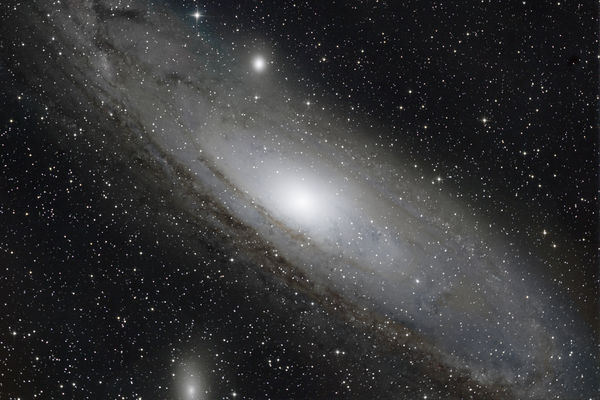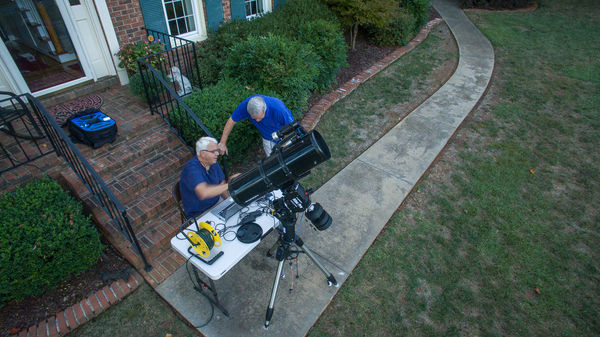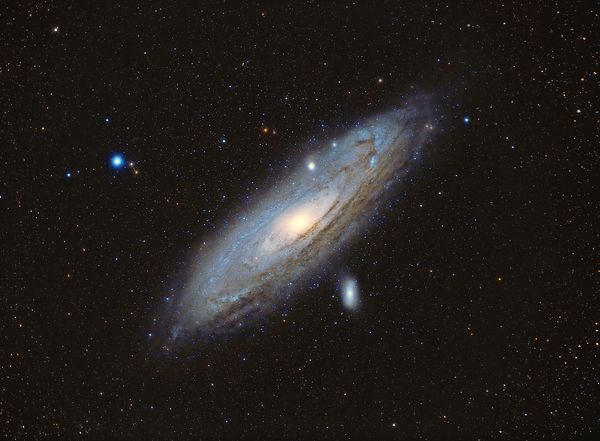I had a few nights with a few clouds but not getting the info I get excited about....practice practice and more practice.
Oct 2, 2016 20:41:07 #
First and most important - I haven't been around much lately and hope that everyone is doing great!!!!! I miss this place and the night sky!
________ Now my post
With a forecast of 4 straight days with 23 to 35 percent cloud cover I decided to set up. All of this was going to be shot between 11:00 pm and 1:30 am....as I was working all four nights....and my target M31 was going to be near the meridian around 1:45am - quit'n time for me..
So I shot all four nights - Exposure settings F/4, ISO 200, 150 seconds. I used the 8 inch Newt, Nikon D800e (set at the crop sensor settings). I kept 140 of the best lights - 200 flats, 20 darks (didn't feel I needed many at ISO 200), 80 bias.) I thought with this much data and 200 ISO - I would have a super dooper M31. Back to the drawing board! I think the transparency and seeing conditions did the damage - they were classified from poor to average - with no night of good or excellent ratings. Although I was shooting over the light polluted skies city of Spartanburg - M31 was pretty high in the sky - especially the last hour of images.
I have added a so so image of M31 plus a view from 20 foot (I was flying a drone) of me with my neighbor who comes out and plays with me from time to time, when his wife lets him. I let him take the drone controls and he giggles like a kid flying it all over our neighborhood.
________ Now my post
With a forecast of 4 straight days with 23 to 35 percent cloud cover I decided to set up. All of this was going to be shot between 11:00 pm and 1:30 am....as I was working all four nights....and my target M31 was going to be near the meridian around 1:45am - quit'n time for me..
So I shot all four nights - Exposure settings F/4, ISO 200, 150 seconds. I used the 8 inch Newt, Nikon D800e (set at the crop sensor settings). I kept 140 of the best lights - 200 flats, 20 darks (didn't feel I needed many at ISO 200), 80 bias.) I thought with this much data and 200 ISO - I would have a super dooper M31. Back to the drawing board! I think the transparency and seeing conditions did the damage - they were classified from poor to average - with no night of good or excellent ratings. Although I was shooting over the light polluted skies city of Spartanburg - M31 was pretty high in the sky - especially the last hour of images.
I have added a so so image of M31 plus a view from 20 foot (I was flying a drone) of me with my neighbor who comes out and plays with me from time to time, when his wife lets him. I let him take the drone controls and he giggles like a kid flying it all over our neighborhood.
Oct 2, 2016 22:21:47 #
Oct 2, 2016 22:41:26 #
Oct 2, 2016 22:47:14 #
skylane5sp wrote:
That's a "so-so" image?
Yes and yes!....
I did this last year on a vixen ED81s refractor ...it turned out to be the best one I have done...and perhaps my best "up" image todate. But it was taken in very good seeing conditions...It was either taken with the same camera or the Nikon D810a...both modified.
Oct 2, 2016 22:52:25 #
Albuqshutterbug wrote:
Beautifully done.
Is that an 8" on an Atlas mount?
Is that an 8" on an Atlas mount?
Yes and with the camera set to a 1.5 crop factor - it was more FOV than I needed....but I knew it going in. The file size at this sensor size is 1/2 the full frame sensor setting....cutting calibration, stacking, and registering time by hours. I was just curious at what kind of S/N ratio I would get shooting at 200 ISO and with the F/4 lens I got some decent but not great info at 150 second exposures. ....some of the folks on here would know the answer - would it make sense to use a focal reducer on a F/4 aperture - my guess it would be a total mess.
Oct 3, 2016 00:44:04 #
Welcome back, I thought you were hibernating till the skies cleared...nice, capture, obvious not as good as your last, that's a fantastic one.
Oct 4, 2016 13:39:44 #
nikonshooter wrote:
First and most important - I haven't been around m... (show quote)
Beautiful work Ed. Do you really need 200 flats???
A question, how long are your flat shots.
Craig
Oct 4, 2016 14:21:33 #
CraigFair wrote:
Beautiful work Ed. Do you really need 200 flats???
A question, how long are your flat shots.
Craig
A question, how long are your flat shots.
Craig
Not sure I know. When I have dust on my sensor...and I do, and my OTA has crap all over it ...and it does, I shoot them because it doesn't take any time to do so. ..and I would rather have them and not need them - than need them and not have them (as the saying goes) I shoot the early morning sky (if no clouds) at aperture priorioty - using the same ISO (which was 200 in that case) I takes 5 minutes to click the shutter and save to an SD card.....then use Adobe Bridge to batch rename (flats) and put in my folder for that night. I usually get clean images when doing so.
I have attached a flat so you can see the crap on my OTA.
Oct 4, 2016 14:31:25 #
nikonshooter wrote:
Not sure I know. When I have dust on my sensor..... (show quote)
Previously, I went with fewer flats, due to the issue of getting consistent levels, but have resolved that and there is a huge difference between 20 and my current 60. I use the flat t-shirt method.
Oct 4, 2016 14:37:02 #
I only cover my scope if there are clouds - if the sun is in the east - I shoot 45 degrees and west...uncovered. My flats are always better when uncovered.
When you shoot aperture priority - then the shutter will vary with the available light....giving consistent histograms....not that it is important I just do.
Flats are shot much differently when using a CCD camera.
When you shoot aperture priority - then the shutter will vary with the available light....giving consistent histograms....not that it is important I just do.
Flats are shot much differently when using a CCD camera.
Oct 4, 2016 17:58:08 #
nikonshooter wrote:
I only cover my scope if there are clouds - if the sun is in the east - I shoot 45 degrees and west...uncovered. My flats are always better when uncovered.
When you shoot aperture priority - then the shutter will vary with the available light....giving consistent histograms....not that it is important I just do.
Flats are shot much differently when using a CCD camera.
When you shoot aperture priority - then the shutter will vary with the available light....giving consistent histograms....not that it is important I just do.
Flats are shot much differently when using a CCD camera.
I have a CCD and have not shot any flats.
Is there a trick to it???
Craig
Oct 4, 2016 22:26:13 #
Not necessarily a trick - you just have to get the exposure right. I use Astro Photography Tool (similar to Backyard EOS) which has a Flat Tool program for setting up and taking flat frames. This is awesome software - under 50 dollars - and for me, a must when using my CCD camera. You need to make sure your CCD is covered by the software before buying. Most popular brands are.
Oct 4, 2016 22:26:59 #
my experience, and I definitely am far from any authority on this topic, is that EVERY time I attach my camera, I need to take new flats. Then I do it in a "controlled" room/area/environment, I use a t-shirt, pull smooth over the end, use a lamp to illuminate to the proper exposure. I believe most CCDs are in the range of 20-30, I go 20. Even doing this controlled, I do get variance...so I use Nebulosity to match the histrograms of all, then stack them. Again, as Ed mentioned, I found a great change in going from 20 to 60, and maybe more is even better, I have not tried....good luck, not doing this has got to be the biggest mistake of anyone doing astrophotography, IMO.
Oct 5, 2016 08:13:05 #
Europa wrote:
my experience, and I definitely am far from any au... (show quote)
It doesn't matter if your histograms do not match - I prefer it only because I am anal about things - you just do not want info to be lost (clipping). What is important is that your flats are taken without making any changes to your camera's setup. The camera MUST have the exact focus that was used during the shoot ...for that reason I don't change a thing - I don't move a thing. If you shoot mono and use RBGL or Narrowband - you need flats for each filter as each of those little boogers may have crap on them ...crap you thought you removed.
Once again:
If at all possible, do not remove the camera from the telescope.....and if you remove the OTA from the mount - you run the risk of the camera moving slightly or giggling moving dust or crap on your optical train. If you must move it (rain or weather issues), mark it with tape. It needs to be in the same orientation as the light images.Do not move the focus position. Lock it down when you are finished shooting light frames (or even better, before). It is very important that everything in the imaging train is exactly as it was when you shot your light frames. Filters, dew shields, correctors, dust, etc. should be in place and not touched or cleaned.
I would prefer to use the sky with NO T-Shirt. I also am not a fan of light boxes, LCD screens, and softboxes. I have several sekonic light meters....and the variance in luminosity varies wildly across these light boxes, soft boxes, and LCD screens. The closes thing to EVEN luminosity is shooting opposite the sunrise, more toward the NW at 40 degrees works - in the early morning. If you wait too late then you may not be able to lower your exposure time enough to keep from having a blown out "flat". This is a key for my Atik camera.
Oct 5, 2016 11:19:51 #
Thank you both for your insites I will start shooting flats from now on.
Craig
Craig
If you want to reply, then register here. Registration is free and your account is created instantly, so you can post right away.







